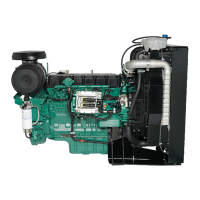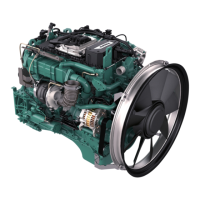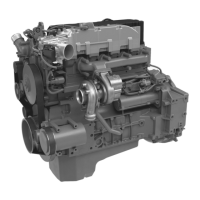Do you have a question about the Volvo Penta TAD872VE and is the answer not in the manual?
Explains the hierarchy of safety warnings (Danger, Warning, Caution, Important, Notice).
Instructions for visual engine checks and details on necessary protective gear.
Importance of safety glasses and warnings about flammable fuels and explosion risks.
Instructions to immobilize engine and requirements for well-ventilated operating areas.
Hazards of moving parts, hot surfaces, and prohibition of start spray use.
Pre-start checks and instructions for electrical work safety.
Safety procedures for working on cooling systems and refueling operations.
Importance of proper fuel quality and safety warnings for handling batteries.
Ensuring correct battery polarity and warnings about electrolyte hazards.
Emphasizes cleanliness for components and states clutch adjustments need engine stopped.
Explains the manual's purpose for safe operation and owner's warranty responsibilities.
Procedures for engine running-in and guidance on using recommended fuels and coolant.
Importance of regular servicing, genuine parts, and warnings against component strain.
Volvo Penta's commitment to environmental care and requirements for certified engines.
Lists engines covered and overviews the EMS Engine Management System.
Explains the EATS system, AdBlue/DEF solution, and monitoring.
Details on AdBlue/DEF tank, heating, storage, and safe handling during operation.
Procedures for cleaning tools and clothing contaminated with AdBlue®/DEF.
Introduction to the DCU II panel, its functions, and menu structure.
Explanation of status bar symbols and types of alarms/messages displayed.
Options for saving/restoring settings and access to dealer-only menus.
Pre-start checks including oil, fuel, coolant levels, and leaks.
Procedures for engine starting, including pre-heating and starter motor limits.
Guidance for cold starts, warning against start spray, and using auxiliary batteries.
Checking instruments after starting and understanding engine alarms.
Risks and consequences of long-term operation at idle or low load.
Recommended procedure for engine shutdown after normal use.
Steps to shut down the engine and turn off the ignition.
Post-shutdown checks and actions for longer breaks.
Purpose of diagnostic function and how to access fault codes via DCU II.
Procedures for resetting the diagnostic function and erasing fault codes.
Guide for fault tracing and explanation of EATS warnings/inducements.
Checks for component defects and details on EATS system fault responses.
Overview of service intervals and where to find the service protocol.
Conditions for extending oil change intervals and the need for oil analysis.
Diagrams of engine components and procedures for general engine inspection.
Instructions for checking and replacing the engine drive belt.
Information on lubrication system, oil level checks, and oil filter replacement.
Steps for changing engine oil and safety precautions for the fuel system.
Detailed steps for replacing the fuel filter and pre-filter.
Importance of the cooling system and guidelines for mixing coolant.
Steps for checking, topping up, refilling, and draining engine coolant.
Detailed steps for cleaning the engine cooling system.
Information on the inlet/exhaust system and safety for filling AdBlue®/DEF.
Steps for changing the AdBlue/DEF pump filter.
Consequences of filling diesel into AdBlue®/DEF tank and vice versa.
Overview of electrical system, main switch, fuses, and battery safety.
Procedures for battery replacement and engine storage.
Specifications for TAD570VE-TAD572VE and TAD870VE-TAD873VE engines.
Data on lubrication system, oil recommendations, and viscosity.
Fuel quality requirements for diesel engines with aftertreatment systems.
Specifications for the cooling system and water quality standards for coolant.
Specifications for electrical system components and identification numbers.
| Engine Model | TAD872VE |
|---|---|
| Number of Cylinders | 6 |
| Fuel System | Common Rail |
| Cooling System | Liquid-cooled |
| Displacement | 7.7 L |
| Aspiration | Turbocharged |
| Emission Standards | Stage V |
| Engine Type | In-line 6-cylinder, 4-stroke diesel engine |











